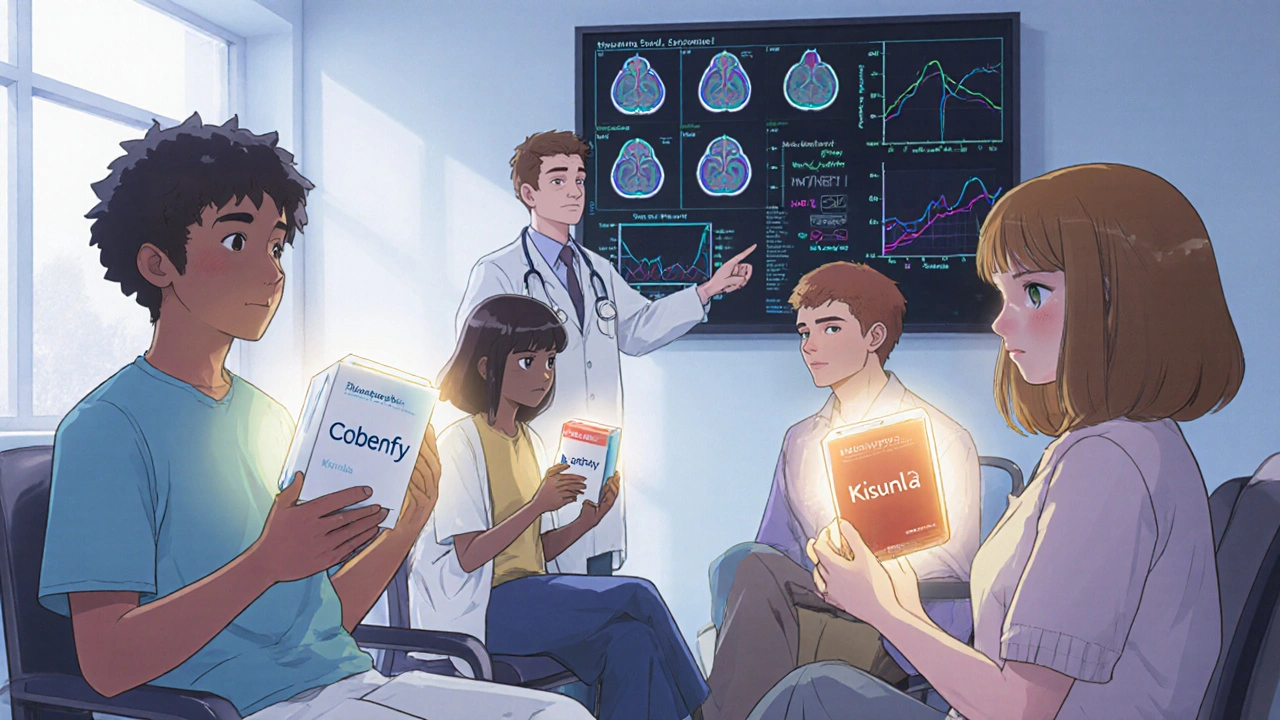New Drug Approvals: Recent Medications and Their Safety Profiles
In 2024, the U.S. Food and Drug Administration approved 50 new molecular entities-the highest number since 2018. That’s not just a statistic. It’s 50 new chances for people living with conditions that had few or no effective treatments. But with every breakthrough comes a question: How safe are these drugs, really? The answer isn’t simple. Some of these medications are changing lives. Others come with unexpected risks that only show up after thousands of people start using them.
Let’s cut through the noise. This isn’t about hype or pharmaceutical marketing. It’s about what’s actually happening on the ground-with real patients, real side effects, and real data from clinical trials and early use.
First-in-Class Drugs: New Mechanisms, New Risks
Almost half of the drugs approved in 2024 were first-in-class, meaning they work in a way no other approved drug does. That’s exciting-but it also means we’re stepping into uncharted territory.
Take Cobenfy (a combination of xanomeline and trospium chloride). It’s the first new schizophrenia treatment in 27 years that doesn’t target dopamine. Instead, it works on muscarinic receptors. In trials, it improved symptoms by 34% compared to placebo. But side effects? Nausea in 12% of users, constipation in 8%. That’s lower than older antipsychotics, which often cause weight gain, tremors, or sedation. Still, this is a completely new pathway. What happens if someone has undiagnosed gastrointestinal issues? Or takes other medications that affect the same receptors? We don’t know yet.
Then there’s Kisunla (donanemab-azbt), the second Alzheimer’s drug targeting amyloid plaques. In trials, it slowed cognitive decline by 35% over 18 months. But 24% of patients developed ARIA-amyloid-related imaging abnormalities. These are brain swelling or bleeding events, often asymptomatic but sometimes serious. The FDA requires strict monitoring with MRIs before and during treatment. Real-world data from early users shows ARIA rates are even higher than in trials-especially in people with two copies of the APOE ε4 gene. That’s a genetic factor many don’t know they have until they’re tested.
These aren’t fluke cases. When a drug hits a biological pathway never touched before, side effects can be unpredictable. That’s why the FDA now requires post-approval safety studies for 24% of new drugs-up from 17% in 2023. These studies track long-term outcomes in diverse populations, not just the mostly white, middle-aged, healthy volunteers in initial trials.
Needle-Free Alternatives: Convenience vs. Effectiveness
Some of the most talked-about approvals aren’t for new diseases-they’re for better ways to deliver old treatments.
Neffy (epinephrine nasal spray) was approved in November 2024. It’s the first needle-free option for anaphylaxis. In simulated use tests, 98% of untrained people got it right-compared to 87% with auto-injectors. That’s huge. For parents, teachers, or anyone afraid of needles, this is a game-changer.
But here’s the catch: it takes 12.3 minutes to reach peak blood levels, compared to 10.7 minutes with an auto-injector. In a severe allergic reaction, every second counts. And early real-world reports from the FDA’s adverse event database show a 22% higher rate of treatment failure in severe cases. That doesn’t mean it doesn’t work-it means it might not work fast enough for everyone. It’s not a replacement for auto-injectors in high-risk patients. It’s an option for those who avoid injections but need a backup.
Same story with Zurnai (nalmefene nasal spray), the first nasal opioid overdose reversal drug. It lasts longer than naloxone-6.2 hours versus 2.1. That’s critical because many opioids, like fentanyl, last longer than naloxone does. But it’s not yet clear if it works as well in people with very high opioid tolerance. Real-world data is still coming in.
Old Drugs, New Uses: What’s Safe When Repurposed?
Sometimes, the biggest wins come from giving old drugs new jobs.
Zepbound (tirzepatide), originally approved for diabetes and weight loss, got the green light for obstructive sleep apnea in December 2024. The SURMOUNT-OSA trial showed a 46% drop in breathing interruptions. That’s impressive. But 32% of users had nausea, vomiting, or diarrhea-side effects already known from its use in obesity. No new risks, but patients with existing GI issues may not tolerate it.
Dupixent (dupilumab), a biologic for eczema and asthma, was approved for COPD in November 2024. It reduced flare-ups by 29%. But 17% of users had injection site reactions-redness, itching-and 9% developed eosinophilia, a rise in white blood cells. That’s higher than in placebo groups. For someone with COPD, who’s already struggling to breathe, this could be risky. The FDA added a warning: monitor eosinophil levels closely.
Even antibiotics are getting updates. Orlynvah (sulopenem etzadroxil/probenecid) was approved for bladder infections in December 2024. It’s a replacement for fluoroquinolones like Cipro, which carry black box warnings for tendon rupture and nerve damage. Orlynvah’s cure rate was 84.3%. Side effects? Mostly stomach upset. No cases of C. diff infection in trials. That’s a big deal for older adults or those on long-term antibiotics.
What’s Coming in 2025: The Next Wave
The pipeline doesn’t stop. Dozens of new drugs are waiting for FDA decisions in 2025.
Cardamyst (etripamil nasal spray) could give people with PSVT-a sudden, scary heart rhythm-a way to treat it at home. In trials, 74% returned to normal rhythm within 30 minutes. Side effects? Mostly nasal irritation. No heart problems. That’s rare for a cardiac drug.
Elinzanetant (dual neurokinin receptor antagonist) targets hot flashes without hormones. In trials, it cut hot flashes by 52%. No increased risk of blood clots or breast cancer-big wins over estrogen therapy. Side effects? Headache, dry mouth, constipation. Simple, manageable.
Wegovy (semaglutide) is expanding beyond weight loss. A new trial showed it improved heart failure symptoms in people with preserved ejection fraction. Weight dropped by 13.3%. Quality of life scores improved. But 44% had nausea or diarrhea. That’s high. And the oral version-coming late 2025-has similar side effects. Will people stick with it? That’s the real question.
And then there’s Nipocalimab (FcRn antagonist for myasthenia gravis). It’s the first drug to block a pathway that clears antibodies from the body. In trials, it improved daily function more than placebo. Infections rose slightly-31% vs. 24% in placebo. But no signs of serious immunosuppression. That’s promising for a disease that often requires long-term immune suppression.

What Patients and Doctors Need to Know
These drugs aren’t magic bullets. They’re tools-with strengths, limits, and risks.
Doctors are being asked to learn new things fast. A 2025 survey of 1,200 primary care providers found that 68% requested extra training on at least one 2024-approved drug. That’s not because they’re unprepared-it’s because the science is moving faster than medical education can keep up.
For patients, the key is asking the right questions:
- Is this drug approved for my exact condition?
- What are the most common side effects-and how often do they happen?
- Are there any monitoring requirements? (Like MRIs for Kisunla or blood tests for Dupixent?)
- How does this compare to what I’m already taking?
- What happens if I stop? Are there withdrawal risks?
The FDA’s REMS program-Risk Evaluation and Mitigation Strategies-is now in place for 12 of the 50 2024 approvals. That means some drugs come with strict rules: mandatory training, special prescriptions, or patient registries. Kisunla requires MRI monitoring. Cobenfy needs patient education on anticholinergic effects. These aren’t red flags-they’re safety nets.
And don’t ignore real-world data. Clinical trials involve thousands. Real-world use involves millions. The FDA’s adverse event database already shows that Neffy has fewer needle injuries but more treatment failures in severe cases. That’s not a reason to avoid it-it’s a reason to use it wisely.
Final Thoughts: Innovation with Caution
The pace of drug development is accelerating. We’re seeing more cures, better delivery methods, and smarter targeting of diseases. But with innovation comes responsibility.
These new drugs aren’t just for specialists. Primary care doctors, pharmacists, and patients all need to understand them. The goal isn’t to rush to the newest option-it’s to choose the right one, for the right person, at the right time.
What’s clear is this: safety isn’t a one-time check. It’s an ongoing conversation. Between doctor and patient. Between regulator and manufacturer. Between data and lived experience.
The drugs approved in 2024 and coming in 2025 are powerful. They offer hope. But hope without understanding can be dangerous. The best medicine isn’t just the newest one-it’s the one used with care, knowledge, and attention to detail.
Are new drugs safer than older ones?
New drugs aren’t automatically safer. They often have fewer long-term side effects because they’re more targeted, but they can carry unknown risks since they haven’t been used by millions yet. Older drugs have decades of real-world data, so their risks are better understood. The trade-off is precision versus predictability.
Why do some drugs need special monitoring?
Drugs with novel mechanisms or serious potential side effects-like Kisunla for Alzheimer’s or Cobenfy for schizophrenia-require monitoring because early trials can’t catch every risk. The FDA uses REMS programs to ensure doctors and patients are trained, tests are done (like MRIs or blood work), and risks are tracked after approval.
Can I trust drug approval timelines?
Yes. Even accelerated approvals go through the same safety standards-they just move faster because they’re for serious conditions with no good options. The FDA doesn’t skip steps; it reorganizes them. Post-approval studies are required for all accelerated approvals to confirm long-term safety.
What’s the difference between breakthrough therapy and priority review?
Breakthrough therapy designation means early data shows the drug may offer a major improvement over existing treatments. Priority review means the FDA will review the application within six months instead of ten. A drug can have both, but they’re different: one is about potential impact, the other is about speed of review.
Are nasal sprays better than injections?
For convenience and ease of use, yes-especially for patients who fear needles. But effectiveness isn’t always the same. Nasal sprays may absorb slower or less completely. Neffy works for most people with anaphylaxis, but auto-injectors are still preferred in life-threatening cases. The best option depends on your condition, risk level, and ability to use the device correctly.
How do I find out if a new drug is right for me?
Talk to your doctor. Ask for the prescribing information, including the FDA-approved label. Check if there’s a REMS program. Look up real-world data from the FDA’s FAERS database. Don’t rely on ads or social media. Your doctor can weigh the benefits against your health history, other medications, and personal preferences.
What should I do if I experience a side effect from a new drug?
Report it to your doctor immediately. Then, file a report with the FDA through MedWatch, their official adverse event system. Even if you’re not sure it’s related, your report helps the FDA spot patterns. Thousands of reports lead to safety updates, label changes, or even drug withdrawals.
Looking ahead, the FDA is testing faster review paths for drugs with the best benefit-risk profiles. That means more breakthroughs could reach patients sooner. But the core principle hasn’t changed: innovation must be paired with vigilance. The goal isn’t just to approve more drugs-it’s to make sure the right drugs get to the right people, safely.


Nishigandha Kanurkar
November 3, 2025 AT 12:30Michelle Lyons
November 4, 2025 AT 12:59Cornelle Camberos
November 6, 2025 AT 02:08joe balak
November 7, 2025 AT 23:07Iván Maceda
November 9, 2025 AT 18:54Vrinda Bali
November 11, 2025 AT 07:43John Rendek
November 12, 2025 AT 13:26Sonia Festa
November 14, 2025 AT 07:58Sara Allen
November 15, 2025 AT 17:01Amina Kmiha
November 16, 2025 AT 19:50